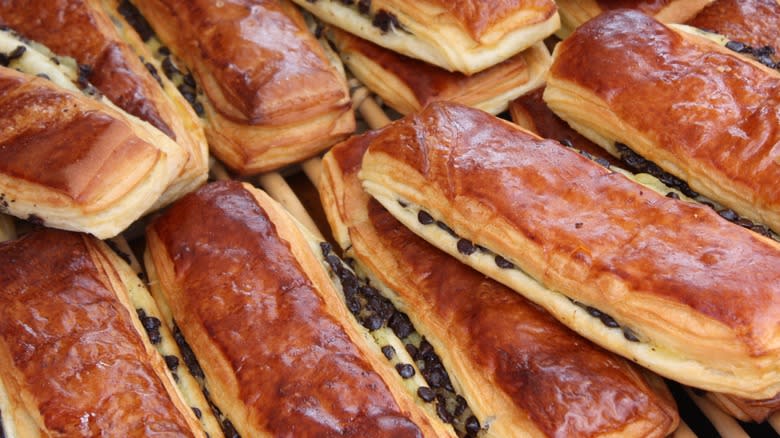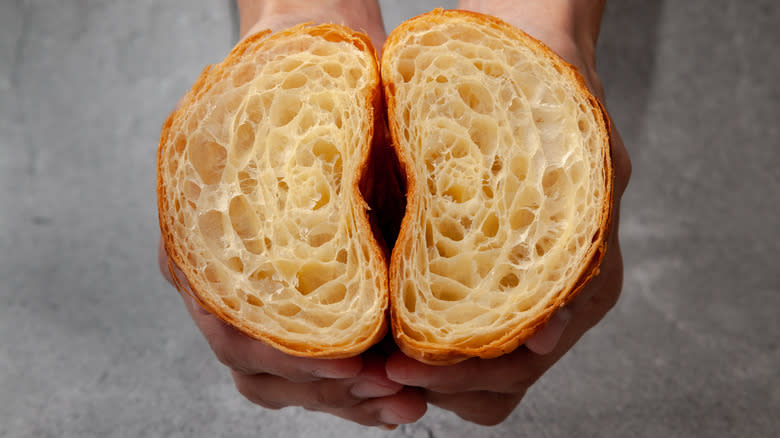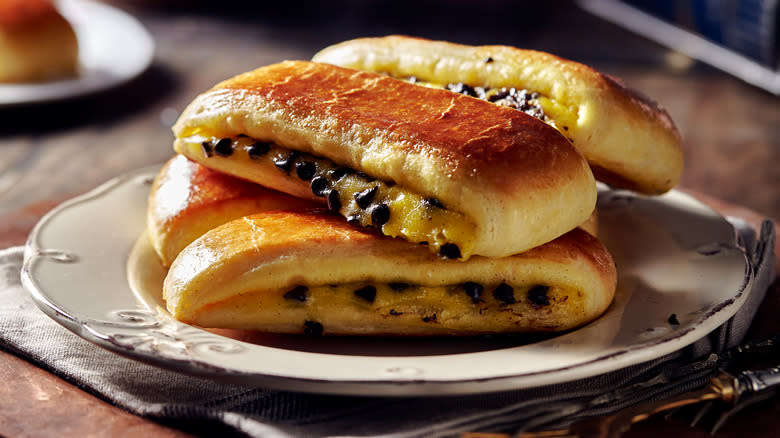Croissant Vs Pain Suisse: What's The Difference?

If you're in the mood for a pastry, a croissant is the classic choice. It is the quintessential French pastry that withholds layers of magic in each bite. It's tempting to stick with what you know when you pop into a bakery to order, but in fact, the croissant is the blueprint for many other pastries. Besides just a pain au chocolate or almond croissant, a croissant's laminated dough can be found in many other French pastries, one of which is the pain Suisse.
Pain Suisse is a lesser-known French pastry made from croissant dough and filled with chocolate chips and a vanilla cream custard. Both croissants and pain Suisse belong in the viennoiserie category of French pastries. Viennoiserie refers to a style of baked goods and pastries inspired by those from Vienna, Austria. In general, viennoiserie contains dough that is made slightly more rich with butter, eggs, or sugar. Croissants and brioche are examples of this. The croissant, in fact, comes from the Austrian kipferl, the original crescent-shaped pastry.
Read more: 15 Mistakes Everyone Makes When Cooking Eggs
Croissants Are Classic

The word croissant means "crescent" in French. It has an elegant, moon-like shape that has made it an iconic symbol of French pasties. To make a croissant is to go on a journey that takes anywhere from one to three days. It's a tasking, rewarding bake that requires a lot of time resting and in the fridge. The process starts with a détrempe, or a simple dough that will be later be laminated with butter. Lamination encloses the butter in the détrempe through a process of folding and shaping. The end result is around 55 layers that bake into flaky delight.
In addition to its shape and layers, another defining quality of a croissant is its butter. A croissant's flavor profile has butter at the forefront -- all those layers are carefully folded to put butter in each bite. That's why when baking a croissant, it's important to use high-quality butter, which will impart an elevated flavor to the croissant that you can notice. It will taste creamy, delicately sweet, and more elegant.
Pain Suisse Can Also Be Made From Brioche

It's not as often that you stumble across a pain Suisse in a bakery, but if you do, it's worth trying. Pain Suisse uses the same type of laminated dough as a croissant, although there is also a variety made from brioche and referred to as brioche Suisse. The brioche provides a light, bready texture that is as equally pleasant as a flaky croissant. This variety is perfect for those who want to try making pain Suisse at home but prefer to cut back on their time in the kitchen. Croissant dough is tough to work with, and that's why it's so highly regarded.
With its cream and chocolate filling, pain Suisse is perfect for those who are looking for a little more substance in their pastry. Pain Suisse takes the shape of a long rectangle that encloses a layer of crème pâtissière (custardy pastry cream) and chocolate chips. To make pain Suisse, the dough is first shaped into a flat rectangle, half of which is spread with the crème pâtissière and sprinkled with chocolate chips. Then, this rectangle is folded in half to sandwich the filling and cut into its signature, log-like rectangles. The triage of buttery pastry, chocolate, and cream makes pain Suisse a more flavorful and rich pastry compared to the croissant. Rest assured they're both still perfect for breakfast.
Read the original article on Mashed.


